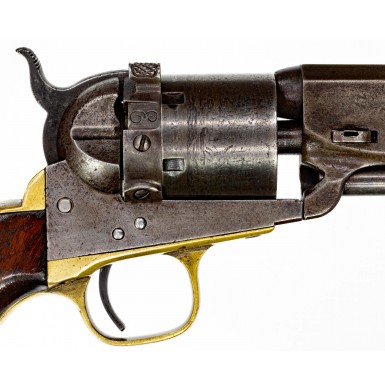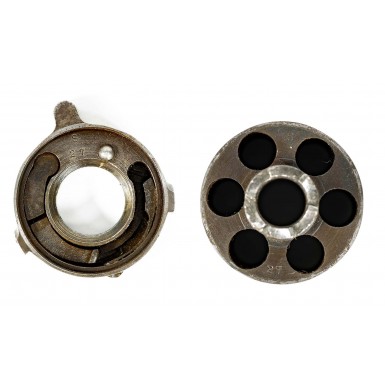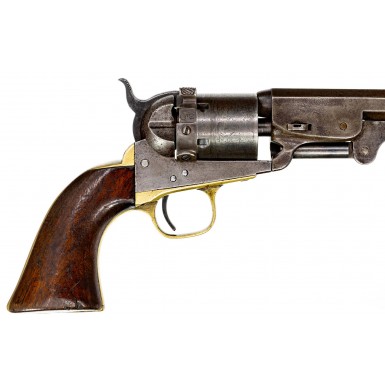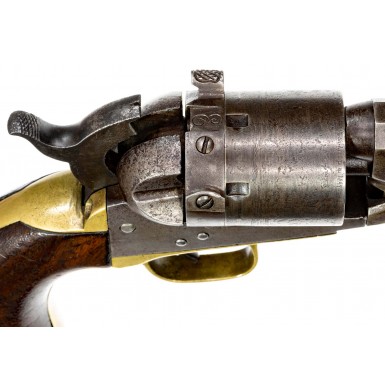Colt Thuer Cartridge Altered Colt Model 1851 Navy Revolver
- Product Code: FHG-TB654-SOLD
- Availability: Out Of Stock
-
$1.00
With the end of the American Civil War, the Colt Patent Firearms Manufacturing Company found itself at a crossroads. The age of the percussion revolver was rapidly coming to an end and the war had proved that the new self-contained metallic cartridges were the wave of the future. The Colt company knew that a metallic cartridge revolver had to be offered to their customers in short order if the company was to remain viable in the new market. Unfortunately for Colt the basic design concept that made such revolvers practical was the bored-through cylinder, a design that had been patented by Rollin White in 1855. The opportunity to acquire those patent rights had been offered to Samuel Colt at that time, but he passed on them, allowing the two men that would become his primary competitors, Horace Smith and Daniel Wesson to secure those rights. With Smith & Wesson in complete control of the bored-through cylinder patent, Colt, and every other American handgun manufacturer would be hobbled in the development and production of a cartridge revolver until White’s patent protection expired in April of 1869.
With the market for percussion revolvers ebbing due to the end of the Civil War and the huge numbers of military surplus percussion handguns on the market, the Colt company looked for a way to enter the cartridge revolver market while not running afoul of the Rollin White patent. The end result of these efforts were the invention of Colt employee F. Alexander Thuer. Thuer would obtain three patents for firearms innovations during his career. His first, #82258 of 15 September 1868 was for the process to alter a percussion revolver to a cartridge revolver utilizing what would be known as the “Thuer” system and which would be the basis for the first cartridge revolver brought to market by Colt. The second, #98529 was granted on 4 January 1870, and was for the tools and processes required for the reloading of Thuer patent cartridges. His final patent, #105388 of 12 July 1870 was for a breechloading, single shot metallic cartridge derringer that would remain in the Colt product line into the 20th century.
The Thuer alteration design was somewhat complicated and unconventional but neatly evaded the Rollin White patent. The centerfire metallic cartridges were slightly tapered from the front to the rear and loaded into the cylinder chambers from the mouths, rather than from the rear of the chambers. In order to alter the gun from percussion to Thuer cartridge, the rear portion of the cylinder that originally contained the percussion cones (nipples) was machined away, leaving only the central core of that part of the cylinder and the accompanying ratchet on the rear face of the cylinder. A conversion ring was manufactured that contained the floating firing pin and the somewhat convoluted ejection mechanism. The ring had a hollow center through which the rear of the newly machined cylinder passed and was situated between the rear of the cylinder and the face of the recoil shield. The conversion ring had a checkered protruding knob on the top that allowed the ring to be rotated into three different positions behind the cylinder. These were a “fire” position, a “safe” position and an “eject” position. The “eject” position was identified by a hand engraved script E, which when aligned with the hammer allowed the cartridges to be removed from the chambers. The safety position was with the ring’s operating knob in the upright position, allowing the hammer to be lowered onto it and rendering the firearm incapable of firing. The fire position was to the right of the knob and allowed the gun to function normally. The original single action mechanism remained intact. When the “E” was aligned with the hammer, operating the action and pulling the trigger dropped the hammer onto a spring-loaded pin which drove a complex series of spring levers in the conversion ring to apply force to the rear of the cartridge that was aligned with the usual loading port of the gun and help push it out of the chamber. To ease the insertion and removal of the tapered cartridge from the cylinder, the loading recess in the barrel web had to be enlarged and lengthened, most notably on revolvers with octagonal barrels. Another of the modifications that was made to the revolver during the Thuer alteration process was the drilling and tapping of the face of the loading lever plunger to accept the Thuer tools needed to reload cartridges, which effectively turned the loading lever into a reloading press. Finally, a small steel disc was set into the face of the hammer nose to reinforce the hammer as it would be striking the hardened steel firing pin and the steel ejector pin in the rear of the conversion cylinder on a regular basis. The conversion rings were typically marked with a two-line patent date referring to Thuer’s original patent. That marking was stamped:
PAT. SEP.
15. 1868
In America, the large majority of the Thuer alterations were performed at the Colt factory. In Great Britain, most Thuer alterations were performed by local contract gunsmiths using Thuer alteration parts sent from America, which included both newly machined cylinders and conversion rings. These alteration kits were available for sale in America as well, for those owners who wanted to update their revolver to the Thuer system. One of the distinct advantages of the Thuer alteration was that the original percussion cylinder could be retained, a new Thuer cylinder and conversion ring added, and the gun could easily be changed between cartridge and percussion. The Thuer system was utilized on nearly all of the firearms in the Colt product line but saw the most use on the larger frame revolvers with the Model 1860 Army, Model 1851 “Old Model” Navy and Model 1861 “New Model” Navy being the most often encountered alterations. The system was also used on the 1849 Pocket Model, as well as both the 1862 Police and 1862 Pocket Navy revolvers. Interestingly, because of the geometry of the Thuer conversion ring and the way the extractor system has to align with the frame for loading and unloading, even the 5-shot percussion pocket revolvers were produced as 6-shot Thuers. Although examples are known of the Thuer alteration on 1855 Sidehammer revolvers and rifles, these are considered experimental alterations only. The most recent scholarship on the subject of Thuer alterations argues that essentially all guns so modified were “new old stock” at the Colt factory, and that guns were not returned to the factory by owners for the modification. This seems an unlikely blanket statement and longtime Colt historian R.L. Wilson certainly noted that some guns were returned to the factory to be modified.
The Thuer alteration system was not particularly popular or successful, with the estimates of all Colt’s altered to the Thuer system as somewhere under 5,000 total. As noted, most of those alterations appear to have occurred on M1860 Army, M1851 and M1861 Navy revolvers. More were apparently preformed in England than in America if the surviving examples are any indication. The Thuer model became available in 1869, at about the same time as the Rollin White patent was expiring and remained in production through sometime in 1872, when the newly introduced conventional bored-through cylinder Colt Richards alterations superseded the front-loading Thuer product line. With less than 5,000 guns altered to the Thuer system and with most of those apparently altered in England, American Thuer alterations are extremely rare guns that are not regularly found on the market for sale today. They are extremely important as they represent the first of the Colt cartridge revolvers and are the book end of any collection of Colt metallic cartridge firearms, with all other models following the introduction of the Thuer in 1869.
Offered here is one of the scarce, American Altered Colt Thuer Revolvers that appears to be one of the rarely encountered examples that was returned to the Colt factory for the upgrade. The gun is a mid-production 4th Model Colt 1851 Navy Revolver with the serial number 164499, which places its manufacture in the latter part of 1863. For those authors and researchers who subscribe to the theory that only unsold guns at the Colt factory were altered to the Thuer system, this gun make that seem quite unlikely. At the height of the Civil War, it would be hard to believe that Colt had many unsold M1851 Navy revolvers just sitting on the shelves and it seems even more unlikely that the gun would still be sitting there some six years later, unsold, and just waiting to be altered to the Thuer system. The gun shows the usual features associated with a Colt factory alteration, including the Thuer conversion ring, the modified original cylinder with matching serial number, the drilled and tapped loading lever plunger, the machined right side of the barrel web to aid in loading and a reinforced hammer nose. Only this last feature appears to potentially be non-factory and will be discussed later. In the cases of Thuer alterations performed by gunsmiths outside of the Colt factory, a conversion kit would be purchased which included the conversion ring and a Thuer machined cylinder, which was typically not numbered or may have been numbered to another gun and sent out as part of the alteration kit. Rarely would a gunsmith alteration include the original, correctly numbered cylinder as the machining process was beyond the capabilities of all but the most advanced machine shops of the time. Additionally, the Colt factory alterations applied a mating number to the rear of the re-machined cylinder and the face of the conversion ring. In this case, the matching alphanumeric S / 27 is stamped on both pieces.
The Factory Thuer Alteration Colt 1851 Navy Revolver offered here remains in about GOOD+ to NEAR VERY GOOD condition. The gun is complete with all matching numbers, except for the wedge, which is an unnumbered replacement. The full serial number, 164499 is found on the barrel, frame, triggerguard, butt and cylinder, with the partial number 4499 on the loading lever and arbor pin. As noted, the rear of the cylinder and the face of the conversion ring have the Colt factory assembly code S / 27 stamped on them. The 7 ½” octagonal barrel has the standard one-line New York address that reads:
- ADDRESS COL. SAML COLT NEW-YORK U.S. AMERICA –
The address remains clear and fully legible. The lower left side of the frame is stamped in two lines: COLT’S / PATENTand the left rear of the triggerguard is marked 36 CAL. The Thuer conversion ring is clearly engraved with a script E at the ejection position and is marked with the
two-line Thuer patent date PAT. SEP. / 15. 1868 to the right of the ring adjustment knob, above the stop boss stud. This marking is very weak and almost illegible due to pitting.
As noted, the gun remains in about GOOD+ to NEAR VERY GOOD condition. It retains no finish and has a mostly dull smoky and pewter gray patina on the steel with scattered areas of darker age staining and oxidized discoloration. Except for the Thuer markings on the conversion ring and the serial number on the loading lever, all of the markings remain clear and legible. The metal is primarily smooth with some scattered patches of surface oxidation and roughness, some pinpricking here and there, some minor impact marks and dings and some light pitting. The pitting is most prominent on the conversion ring at the Thuer marking, and in small, freckled patches around the muzzle, on the frame here and there, on the recoil shield on the left of the frame, and on the barrel web forward of the cylinder chambers. The cylinder shows moderate wear and some scattered impact mark, with the roll engraved scene being light and only about 30% visible. As noted, the right side of the frame has been machined and relived, increasing the size of the original loading groove to accept the Thuer cartridges. The plunger of the loading lever has also been drilled and tapped for Thuer reloading tools. As mentioned above, the face of the hammer is the only apparently “non factory” modification. The factory system involved inserting a hardened disc in the face of the hammer nose as a reinforcement. In this case, it appears that small plate was used to reface the hammer as a reinforcement. There is the apparent shadow of a circular disc in the hammer face, and in my opinion that disc either failed or wore significantly, resulting in the addition of the small plate. This would be similar to refacing or “shoeing” the frizzen on a flintlock after it became too worn to function correctly. As the revolver shows all the signs of seeing heavy use during its lifetime, it is not unlikely that the factory reinforcement was insufficient for the amount of use the revolver saw. The revolver remains mechanically functional and although a little loose in the frame to barrel fit, still functions as it should. The action works correctly on all positions and the cylinder times, indexes, and locks up as it should. The Thuer conversion disc also operates as it should, rotating and locking into the firing, safety, and extraction positions correctly. The bore of the gun remains in about GOOD condition and retains strong rifling. The bore shows moderate amounts of pitting along its length, again an indication that this Thuer revolver saw a significant amount of use. The brass triggerguard, grip frame and backstrap retain none of their silver plating and have a mellow golden color, suggesting an old cleaning that is starting to tone down. The one-piece varnished walnut grip is in about GOOD condition as well and shows moderate wear, commensurate with the balance of the revolver. The grip is numbered in period ink on the interior, but the marking is weak and smeared and not legible. The fit and wear of the grip suggest it is certainly the original grip for the gun. The grip retains some varnish with moderate wear and rounding to the sharp edges, along with scattered bumps, dings mars and impact marks. Wear patterns, particularly on the flared lower edge of the left side of the grip suggest a lot of holster carry and a large oval impact mark is present above this wear on the left of the grip as well.
Overall, this is a solid, complete, and correct example of a scarce Colt Model 1851 Navy Thuer Alteration Revolver. The gun shows real world use and lots of carry, but no real abuse. It is a scarce example of the first of the Colt cartridge revolvers and a good example of the earliest cartridge Colts that journeyed west to tame the frontier in the post-Civil War period. The gun has nice, unmolested look and is reasonably priced for a Thuer revolver. Interestingly some authors note that Thuer’s can be found in nice condition because they saw little use. While this may well be true of the more plentiful English proved Thuer revolvers, this American altered gun clearly saw a lot of use. The 1863 production of the revolver makes it interesting as well and it would be very interesting to know who owned it and who returned it to the factory for the cartridge upgrade sometime between 1869 and 1872. These guns do not appear on the market regularly and this one certainly has a story to tell, if only it could talk. If you collect the cartridge Colt revolvers of the Old West period, this is one of the guns you must have in your collection, but that rarely comes to market and even less often for a reasonable price. Don’t miss you chance to own a real piece of Colt firearms history.
SOLD
Tags: Colt, Thuer, Cartridge, Altered, Colt, Model, 1851, Navy, Revolver





















